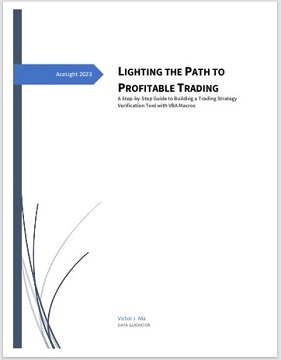Set it and Forget it:
How Automated Trading Strategies Can Revolutionize Your Stock Market Game
|
|
Have you ever heard the phrase "set it and forget it"? It's a phrase that's
often used to sell kitchen appliances like slow cookers and air fryers. But
did you know that you can also apply this concept to your stock trading
strategy? Yes, that's right, you can set it and forget it - as long as you
have an automated trading strategy in place!
Gone are the days of
hunching over your computer screen, anxiously waiting for the right moment
to make a trade. With an automated trading strategy, you can sit back,
relax, and watch your profits roll in - or so they say. Of course, as with
any investment strategy, there are risks involved. But hey, at least you
won't have to worry about getting carpal tunnel from all that clicking!
Now that we've got the comedic relief out of the way, let's dive into
the nitty-gritty of automated trading strategies and how they work in the
stock market.
Stock market automated strategies are becoming
increasingly popular among traders and investors alike. These strategies are
based on algorithms and rules that are programmed to identify potential
trading opportunities and execute trades automatically. The use of automated
trading systems has several benefits, including increased speed, efficiency,
and accuracy, which can help traders achieve better results. In this blog,
we will explore the concept of automated trading and its advantages and
disadvantages, as well as some popular automated trading strategies.
What is automated trading?
Automated trading, also known as
algorithmic trading or mechanical trading, refers to the use of computer
programs to execute trades in financial markets. These programs are designed
to analyze market data and identify trading opportunities based on specific
criteria, such as technical indicators, price patterns, or fundamental data.
Once a trading opportunity is identified, the program executes the trade
automatically, without the need for human intervention.
Automated
trading systems can be designed to trade a variety of financial instruments,
including stocks, futures, options, and forex. These systems can also be
used for different trading styles, such as day trading, swing trading, or
position trading.
Advantages of automated trading
There are
several advantages to using automated trading systems, including:
1.
Increased speed and efficiency: Automated trading systems can execute trades
much faster than human traders, which can be crucial in fast-moving markets
where timing is critical.
2. Improved accuracy: Automated trading
systems are not subject to human emotions or biases, which can lead to more
consistent and objective trading decisions.
3. Backtesting and
optimization: Automated trading systems can be tested and optimized using
historical data, which can help traders identify the best trading strategies
and parameters.
4. Reduced workload: Automated trading systems can
monitor the markets 24/7 and execute trades automatically, which can save
traders time and effort.
Disadvantages of automated trading
While there are many advantages to using automated trading systems, there
are also some potential disadvantages to be aware of:
1. Technical
issues: Automated trading systems can be affected by technical issues such
as connectivity problems, hardware failures, or software bugs, which can
lead to trading errors or losses.
2. Lack of flexibility: Automated
trading systems are based on pre-programmed rules and algorithms, which can
limit their ability to adapt to changing market conditions or unexpected
events.
3. Over-optimization: Automated trading systems can be
over-optimized to historical data, which can lead to poor performance in
real-world trading conditions.
4. No guarantee of success: While
automated trading systems can improve trading efficiency and accuracy, there
is no guarantee that they will always be profitable, and losses can occur.
Popular automated trading strategies
There are many different
automated trading strategies that traders can use, depending on their
trading style, preferences, and risk tolerance. Here are some popular
examples:
1. Trend-following strategies: These strategies use
technical indicators such as moving averages, trendlines, or momentum
indicators to identify trends in the market. When a trend is identified, the
system will buy or sell based on the direction of the trend.
2.
Mean-reversion strategies: These strategies are based on the idea that
prices tend to revert to their mean over time. The system will buy or sell
when prices deviate from their average, with the expectation that they will
eventually return to their mean.
3. Breakout strategies: These
strategies are based on the idea that prices tend to break out of their
trading ranges when they reach a certain level of support or resistance. The
system will buy or sell when prices break out of their range, with the
expectation that they will continue in the direction of the breakout.
4. News-based strategies: These strategies are based on news or other
fundamental data that can affect the market. The system will monitor news
sources and automatically buy or sell based on the information received.
5. High-frequency trading strategies: These strategies are based on the
use of complex algorithms and high-speed trading technology to execute
trades in milliseconds or microseconds. These strategies rely on market data
feeds and co-location services to minimize latency and gain an advantage
over other traders.
While high-frequency trading (HFT) strategies are
not suitable for all traders, they have become increasingly popular in
recent years due to their potential for high returns and low risk. However,
HFT strategies are also subject to regulatory scrutiny and can be affected
by technical glitches or market disruptions.
Implementing an
automated trading strategy
To implement an automated trading
strategy, traders will need to have a basic understanding of programming and
trading platforms. They will also need to select a programming language,
such as Python, C++, or Java, or even VBA, and a trading platform or API
that supports automated trading.
Once a programming language and
trading platform have been selected, traders can start building their
trading system. This involves defining the rules and algorithms that the
system will use to identify trading opportunities and execute trades.
 Traders
will also need to back-test and forward-test their trading system using
historical data to ensure that it performs well under different market
conditions. Backtesting involves running the trading system on historical
data and analyzing its performance based on metrics such as profit and loss,
win rate, and drawdown. Traders
will also need to back-test and forward-test their trading system using
historical data to ensure that it performs well under different market
conditions. Backtesting involves running the trading system on historical
data and analyzing its performance based on metrics such as profit and loss,
win rate, and drawdown.
For any trading strategy
and indicator, no
matter how good it sounds, we must test it before using it in the real
market. These tests include back-testing and forward-testing. Without proper
testing, trading will turn into guesswork or even worse, gambling. For more details, click
LIGHTING THE PATH TO PROFITABLE TRADING: A Step-by-Step Guide to Building a Trading Strategy Verification Tool with VBA Macros to get the whole tutorial handbook for free!
And click Free Trial to download strategies testing tools, all for a 30-day Free Trial.
Click on Subscription to order more strategies testing tools to help your stock trading.
After the trading system has been backtested and optimized,
traders can start running it in live trading conditions. They will need to
monitor the system's performance and make adjustments as necessary to ensure
that it continues to perform well over time.
And there you have it,
folks! With an automated trading strategy, you too can be the proud owner of
a portfolio that's worth...well, we can't make any guarantees. But at least
you'll have more time to pursue your other passions, like baking sourdough
bread or binge-watching Netflix.
Just remember, automated trading
isn't a one-size-fits-all solution. It's important to do your research,
choose the right platform, and carefully monitor your system's performance.
And who knows, maybe one day you'll be able to retire to a private island
thanks to your stock market savvy. Or maybe you'll just be able to afford an
extra scoop of ice cream on your sundae. Either way, it's worth a shot!
|


|

Free Tutorial
Share
|
|
|
|